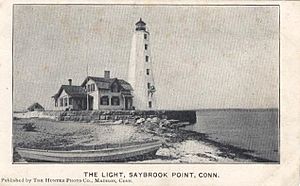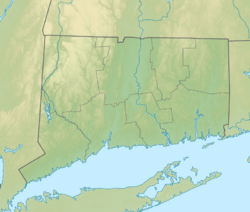Lynde Point Light facts for kids
 |
|
| The lighthouse as it appeared about 1905 | |
|
|
|
| Location | Old Saybrook Connecticut United States |
|---|---|
| Coordinates | 41°16′17.4″N 72°20′35.2″W / 41.271500°N 72.343111°W |
| Year first constructed | 1803 (first) |
| Year first lit | 1839 (current) |
| Automated | 1975 |
| Foundation | granite pier |
| Construction | brownstone blocks tower |
| Tower shape | octagonal tower with balcony and lantern |
| Height | 65 ft (20 m) |
| Focal height | 71 ft (22 m) |
| Original lens | 10 lamps, 9 inch reflectors (1852 removed) |
| Current lens | Fifth order Fresnel lens (1890) |
| Characteristic | F W |
| Admiralty number | J0746 |
| ARLHS number | USA-462 |
| USCG number | 1-22520 |
The Lynde Point Light, also called the Saybrook Inner Lighthouse, is an important lighthouse in Connecticut, United States. It stands on the west side of the Connecticut River's mouth, where it meets the Long Island Sound in Old Saybrook, Connecticut.
The first lighthouse here was a 35 feet (11 m) tall wooden tower. It was built in 1803 by Abisha Woodward. Over time, a new lighthouse was needed. So, in 1838, money was set aside for a stronger one. Jonathan Scranton, Volney Pierce, and John Wilcox built the new 65-foot (20 m) octagonal tower using brownstone blocks. This new lighthouse was finished in 1838 and first lit in 1839.
The lighthouse has been updated many times. Its original lamps were replaced with a special Fresnel lens in 1852 and then again in 1890. This type of lens helps make the light much brighter and easier to see. The Lynde Point Lighthouse first used whale oil, then kerosene, and was finally electrified in 1955. The United States Coast Guard made it fully automatic in 1978, meaning no keeper was needed anymore. In 1990, it was added to the National Register of Historic Places because of its excellent stone construction.
Contents
The First Lighthouse
People in Old Saybrook needed a lighthouse to guide ships into the harbor. The government bought land from William Lynde for $225 to build it. Abisha Woodward built a 35 feet (11 m) wooden tower, which was finished in 1803.
Over time, the land around the lighthouse started to wear away. To protect it, a seawall was built in 1829 and made stronger in 1831. A small house with six rooms was also built for the lighthouse keeper. This keeper's house was later replaced in 1933.
Sailors often complained that the first light was too short. It was hard to see, especially when fog rolled in from the nearby marshland. People asked for the tower to be made 25 feet (7.6 m) taller. But instead, it was decided that building a brand new, taller lighthouse would be a better idea.
The Current Lighthouse
By 1832, the United States Congress started setting aside money for a new lighthouse. More funds were added in 1838. The job to build the new lighthouse went to Jonathan Scranton, Volney Pierce, and John Wilcox. They were from Madison, Connecticut.
The new 65-foot (20 m) octagonal (eight-sided) tower was built from brownstone in 1838 and first lit in 1839. The walls at the bottom of the lighthouse are 5 feet (1.5 m) thick. They get thinner as they go up, reaching 2 feet (0.61 m) thick at the top. The lighthouse is painted white and has six windows that all face the water. Experts say its stone work is very impressive.
In 1886, another lighthouse, the Saybrook Breakwater Light, was built nearby. After this, the Lynde Point Light became known as the "Saybrook Inner Light." The Saybrook Breakwater Light was then called the "Saybrook Outer Light."
The keeper's house from 1833 was replaced in 1858 with a new wooden house. This house had a special roof style called a gambrel roof. In 1966, this house was torn down and replaced with a duplex house, which is a building with two separate homes.
The original ten lamps inside the lighthouse were replaced in 1852. A new, more powerful Fresnel lens was installed. Then, in 1890, an even better fifth-order Fresnel lens was put in. This is the lens still used today.
A fog bell was added in 1854 to help guide ships in foggy weather. Later, in 1856, machinery was installed to make the bell strike automatically. A fog siren was briefly used in 1867 but was replaced by the fog bell again in 1874. A new fog bell was installed in 1883.
The Lynde Point Lighthouse first used whale oil to power its light. In 1879, it switched to kerosene. It was then electrified in 1955. Finally, in 1978, the United States Coast Guard made the lighthouse fully automated, meaning it could operate without a person living there to tend the light.
Why This Lighthouse is Important
In 1990, the Lynde Point Light was added to the National Register of Historic Places. This means it's recognized as an important historical site. Experts praise its "superior stone work" and how well its construction history is documented.
The lighthouse is also important because it shows how the government worked to improve safety for ships. They built lighthouses at the entrances of important harbors and rivers. Today, the Lynde Point Light is still active, helping ships navigate safely. It is not open to the public for visits. The lighthouse was even featured in the 2005 horror movie Predator Island.
Meet the Keepers
Lighthouse keepers were people who lived at the lighthouse and made sure the light was always working. Here are some of the known keepers of the Lynde Point Light:
| Name | Years of Service |
|---|---|
| Cranie | Unknown |
| Daniel Whittlesey | Unknown-1841 |
| Catherine S. Whittlesey | 1841-c. 1850 |
| Henry Clark | circa 1850 |
| James Rankin | 1853–1861 |
| A. H. Bushnell | 1861–1867 |
| Jared Daniels | 1867–1869 |
| Richard Ingham | 1869–1883 |
| John Ninde Buckridge | 1883–1902 |
| Samuel Wright | 1902 |
| Elmer Gildersleeve | 1902–1925 |
| Arthur J. Baldwin | circa 1925–1930 |


